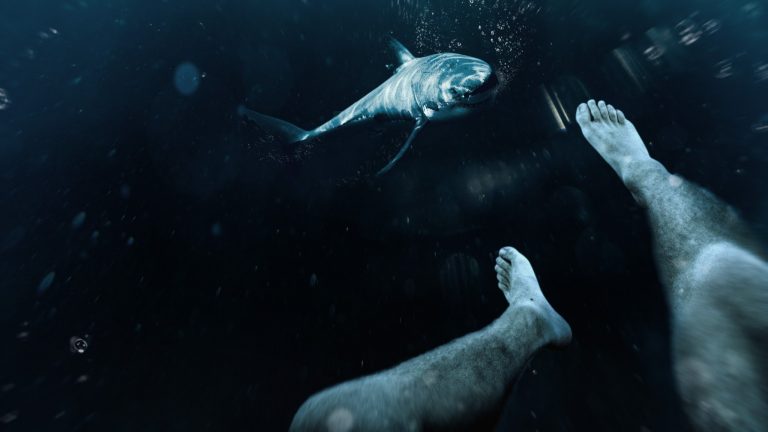You’re on a boat for a little fishing trip. It’s just you, your reel, and the open ocean. You lose track of time, and don’t notice the storm that’s closing in. You jump overboard as the deadly water swallows the boat. Now, you’re trapped in the open ocean. What would you do to stay alive?
Be sure to like and subscribe for more. Oceans cover 70% of the Earth, and we use them for many reasons. Transportation of goods, fishing, cruises, diving, even powering our cities and homes, just to name a few. But oceans are dangerous, with waves that can be 30 m (100 ft) high. And their powerful tides can carry you away from a boat or shore very quickly.
If the water wasn’t enough to worry about, then what lives in it should be. Some ocean residents, including barracudas, are hungry. It is no wonder then that history is full of stories of humans tangling with the ocean and failing. The Titanic, a British cruise liner that struck an iceberg in 1912 and sunk, killing over 1500 people.
In 2015, the El Faro cargo ship sailed into a category 3 hurricane. The ship sank, and all 33 people on board died. If you’re left in the open ocean, what’s your next move?
What if you can’t swim? Could a vegetarian find food? What could you drink if there’s no rain? Being stuck by yourself in the open ocean can be terrifying. You might be able to survive, but you’ll have to act quickly.
Step 1 – Float
The equipment you have with you when you find yourself stranded on the open ocean will play a heavy role in your survival chances. Even if the boat is damaged, it could help you to survive.
It could help you to stay afloat, and stay dry. Your first priority is finding a way to float. Get into a life raft if there is one. Or grab ahold of anything that will keep you on the surface.
You don’t know how long it’ll take to be rescued. So even if you’re a strong swimmer, wear a personal floatation device. These include inflatable life vests and foam vests. Either way, their main task is to keep the wearer floating when they cannot do it themselves.
If you don’t have a PFD, you’ve got two choices. If the water is calm, you can lie on your back. If the water is rough, do a survival float. Take a deep breath of air, and lie stomach-side down. Keep just the back of your head above water, and let your limbs hang beneath you. Re-surface only to breathe.
Step 2 – Stay mentally strong
There is more to survival and staying fed and being warm. You must remain mentally strong and cope with the extreme amounts of stress if you are to see this situation out.
Use a positive attitude and spunk to help you survive. The key is to be goal-oriented. Start small. And remember all the good things in life, so you know what you’re striving for. To fight off loneliness, keep your mind occupied. Whistle, or concentrate on getting food.
Step 3 – Eat Up
Your next challenges are finding food and staying hydrated. Even though you’re in the middle of an ocean, don’t drink that salty water. Find containers you can use to capture rainwater, or let your clothing absorb rain. Drink the water as you wring out your clothes.
If there’s no rain, blood from birds and turtles is 70% water. You can catch turtles if you’re fast enough. If you take up fishing, you can use fish guts as bait to catch birds. In the ocean, food is easier to come by than water. Remember, your body needs water more than food. Water helps you process food, so if you don’t have water, don’t eat.
Use string, thread, or cord can as fishing line. Screws, nails, or any bent metal can be used as hooks to catch fish. If you’re a vegetarian, you can eat any seaweed that floats by, and phytoplankton.
Step 4 – Avoid Exposure
The elements pose a big large risk to your survival. If the water or weather is cold, hypothermia will be your enemy. Make sure there’s no water in your raft or boat. To maintain your body’s heat, do small movements or exercises, and get your blood pumping.
Keep all your limbs close to your body to stay warm. A lot of heat escapes from our heads, so make sure you cover yours. But if it’s hot, heatstroke and dehydration are the threats. Try to stay out of the Sun during the hottest part of the day to avoid sunburn. Cover yourself, so your skin isn’t exposed. A sail or parachute will help. And if you’re getting too hot, wet some clothing to lower your internal temperature.
Step 5 – Help rescuers find you
Now that you’ve adapted to your situation, it’s time to be rescued. Do you have a flare gun? Or, get something shiny to signal planes or ships. A piece of mirrored glass works well.
Staying aware of your surroundings is key to finding a way off the ocean. Watch which direction birds are flying at night, as they’ll head for land. The Sun sets in the west, so use that as a navigation tool. If visibility is poor, listen for waves crashing or breaking, This is key to finding an island. While the environment is harsh, you can survive being stranded in the open ocean.
And you’re not the only creature out there. But what if one of those creatures takes an interest in you, or you’re accidentally caught up in a whale’s feeding routine?
Sources
- “How To Avoid Hypothermia”. Cristen, Conger. Howstuffworks.
- “The Attitude Of Survival”. Conway, Chris. 2021. backcountryattitude.com.
- “How Long Can You Survive Adrift In The Ocean?”. Charles, Bryant. Howstuffworks.
- “How To Survive In Ocean / Open Water – Survive Nature”. 2021. Survive Nature.
- “Can vegetarians eat plankton?”. 2021. uk.answers.yahoo.com.
- ““The Clock Is Ticking”: Inside The Worst U.S. Maritime Disaster In Decades”. Langewiesche, William. 2021. Vanity Fair.


















